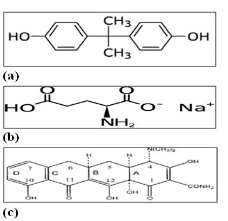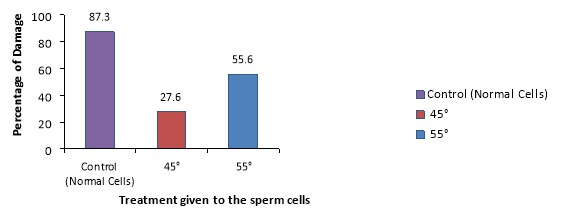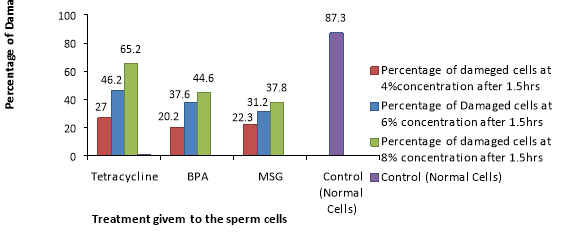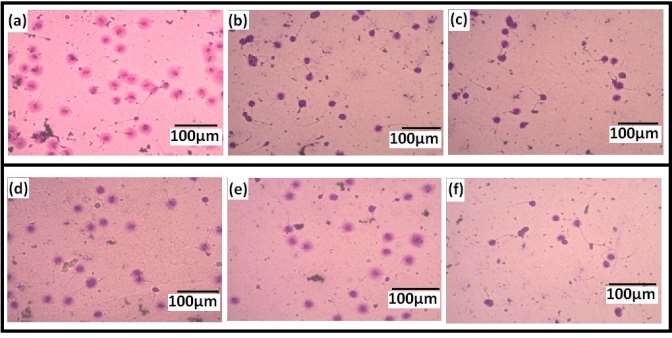Effect of Various Factors on DNA of Human Sperms Essay
Effect of Various Factors on DNA of Human Sperms Essay
In vitro study of the effect of various factors on DNA of Human sperms
Dave Avani1, Jain NK1, Patel Himanshu 2, Patel Madhuri 2, Bhatt Vidisha 2, Patel Komal2, Mallick Sarada3, *Srivastava Pradeep 3
Abstract
Aim: Effect of various clinical compound and environmental conditions were studied for the in vitro fragmentation of the human sperm DNA, as well on the quality of semen samples. Method: The semen samples obtained from different males were then treated further to check the effects of the chemicals taken into consideration. The effects were studied through sperm chromatin dispersion test. Results: Primary results showed that the antibiotic tetracycline was the most effective chemical causing DNA damage, as compared to the other chosen compounds. Conclusion: The study concludes that the tetracycline drug is more efficient then the others in causing fragmentation of the DNA.
Keywords: Sperm DNA, Fragmentation, Tetracycline, Sperm Chromatin Dispersion Test.
INTRODUCTION
The germ line is the most sensitive of all and can be considered as a good candidate for the measurement of the effects caused by the compounds of choice [1-4]. Today infertility is linked to many reasons such as mutation in the sperms or the egg, irradiation, and certain chemicals such as food additives, packaging materials, heat etc. Many articles have been put forward proving the adverse effects of these chemicals on the germ line especially the sperms and its DNA. Effect of Various Factors on DNA of Human Sperms Essay. The paternal genome in mammalian spermatozoa is condensed in a manner that is specific to the cell type presumably to protect the DNA during the transit from the male to the oocyte prior to fertilization. Damaged DNA has been observed in testicular, epididymal and ejaculated sperm. Temporary nicks have been observed in the sperm which were, linked to the topoisomerases activity, facilitate histone-protamine replacement, but if these nicks are not fixed they would evolve into DNA fragmentation on mature sperm [5].
Bisphenol A (BPA) used to make plastics and epoxy resins mainly comes through diet is an organic compound with the chemical formula (CH3)2C(C6H4OH)2[6-8]. It is part of the bisphenols group of chemical compounds with two hydroxyphenyl functionalities. It is a colourless solid that is soluble in organic solvents, but poorly soluble in water. Many studies also have shown that BPA has estrogenic activity in several in vitro and in vivo preparations [8-10].
Monosodium glutamate, also known as sodium glutamate or MSG, is the sodium salt of glutamic acid, one of the most abundant naturally occurring non-essential amino acids[11-13]. Industrial food manufacturers market and use MSG as a flavour enhancer because it balances, blends and rounds the total perception of other tastes. Many experiments have been carried out which have shown the harmful effects of excessive intake of MSG on the development of seminiferous tubules as well as the spermatids[14-15].
ORDER A PLAGIARISM-FREE PAPER NOW
The tetracyclines are a family of antibiotics that inhibit protein synthesis by preventing the attachment of aminoacyl-tRNA to the ribosomal acceptor (A) site. Tetracyclines are broad-spectrum agents, exhibiting activity against a wide range of gram-positive and gram-negative bacteria, a typical organisms commonly given in treatment[10, 16].Effect of Various Factors on DNA of Human Sperms Essay. Many studies in the past indicated that when rats were administered a significant amount of Tetracycline on daily basis the animals showed a decreased level of testosterone ultimately affecting the development of the leydig cell. No direct relationship has been observed till date on changes in the humans but many studies are being carried out to study the detrimental effects of tetracycline on human sperm cells and its DNA[17] (fig.1).

Fig.1.Molecular structure of compounds: a) Molecular structure of Bisphenol A, b) Molecular structure of Monosodium Glutamate & c) Molecular structure of Tetracycline.
MATERIALS AND METHODS
Materials
Sample analysis was done for the healthy men between the ages 25-30 yrs. The inclusion criteria were only healthy men with the age between 25-30 yrs considered. On the hand exclusion criteria of the male were they should free from various diseases like Diabetes, Blood Pressure, Tuberculosis, Sexual Dysfunction & Cardiac problems.
The samples collected from Stem Cure Pvt Ltd, Centre for Reproductive Medicine & Stem cell Development, Ahmedabad, India. The study approved by the Ethical Committee of the Department of Life Sciences, School of Sciences, Gujarat University, Ahmedabad, Gujarat (India).
Sample preparation: 10 semen samples of perfectly healthy male were collected at a collection centre in a sterile jar and were brought to the laboratory. Direct swim-up technique was utilised for preparing the sperm cells for the analysis[18]. The sperm debris including the dead sperm cells was removed prior using by centrifuging the sample in a Phosphate Buffered Saline (PBS) medium at 1000 rpm for 10 minutes[19]. The sperm pellet obtained was overlaid with PBS and incubated at 37oC and the supernatant containing the motile sperms were used for the assay. Effect of heat was comparing with normal cells discussed later in the discussion section.
Chemicals: Bisphenol A (BPA), Tetracycline, Monosodium Glutamate (MSG) , concentrated HCl, 0.4M Tris, 1% β mercaptoethanol, 50mM EDTA, 1% SDS (sodium dodecyl sulphate), pH 7.5 was used for making Lysis I, 0.4M Tris, 2M NaCl, 1% SDS, pH 7.5 was used for making Lysis II[20], 0.09M Tris borate, 0.002M EDTA, pH 7.5 was used for making the wash buffer and pure ethanol. 0.4 gm, 0.6 gm, 0.8 gm of Tetracycline, MSG, & BPA were dissolved in 100 ml of Double Distilled Water (DDW) to get 4%, 6% and 8% of concentration. Individual studies of samples were conducted using individual chemicals separately. Effect of Various Factors on DNA of Human Sperms Essay.
Physical analysis of Semen: Semen sample were physically analysed after the liquefaction, and viscosity were checked by observing the droplets falling from a disposable plastic pipette.
Vitality Staining: The semen sample was studied for the presence of any unwanted materials using vitality staining test. The sample was mixed and a smear was prepared on a glass slide along with eosin-nigrosin stain and was observed under the microscope at 100X magnification after the smear dried completely. The live sperm heads were seen white in colour while the dead sperm heads were stained as pink.
Analysis of DNA fragmentation using the SCD Test: Slides precoated with 1% agarose were used as a base slide. Final concentration of 15-20 million sperms were mixed with 1% low melting point agarose overlaid onto base slide and covered with coverslip[21]. The slides were kept at 4°C to get the gel solidified and later the coverslips were removed carefully. No reduction was observed, however minute reduction was there maintained with PBS.
Chemicals of different concentrations i.e. 4%, 6%, and 8% (Tetracycline, MSG and BPA should be prepared freshly prior to the analysis). The slides were kept in these individual solution for time 1.5hrs and 3hrs respectively, study effect of heat was made by heating the agar mixed sample containing the slides of sperm the agar bath was heated at 45oC 55oC and 60oC.
After the incubation period the slides were immediately removed and dipped in 0.08N HCl for 7minutes. The slides were then kept for Lysis in two cycles of 10 minutes followed by 5 minutes respectively. The slides were then washed with PBS buffer and dehydrated with 70%, 90% and 100% ethanol for 2minutes respectively. The slides were allowed to dry and are then observed under visible light using geimsa stain [5, 22].
RESULT
Semen Analysis: The result of physical analysis of semen is as shown in Table 1. The semen samples studied were free of any contaminants and appeared normal. The pre and post wash count were also carried out which showed that the semen samples were perfectly healthy. The viscosity and the volume of each sample under study were within the normal range as suggested by the world health organisation standard.
Analysis of DNA fragmentation using the SCD (Sperm Chromatin Dispersion) Test
The SCD test carried out depict the effect of the chosen compounds on the sperm DNA which are represented as below.
(A) Effect of Heat:- Sperm sample were subjected to heat treatment in water bath for 1.5 hrs at the temperature of 45oC and 55oC, where normal temperature of 28oC was used as control. The results are shown in fig 2.0.
(B) Effect of Chemicals:-The studies were made on the percentage damage observed after chemical treatment to the sperm cells for 1.5 hrs and 3hrs of incubation time.Effect of Various Factors on DNA of Human Sperms Essay. Fig 3.0 and 4.0 depict the effect of tetracycline, BPA and MSG on sperm cells for 1.5 hrs and 3.0 hrs of incubation time respectively. Sperm cells without chemicals but buffer solution were taken as control. Various concentrations of chemicals viz, 4 – 8% was taken for the study.
It was observed that tetracycline causes the maximum damage of about 92.4% after an incubation time
3hrs at 8% concentration, while the treatment with heat, monosodium glutamate and bisphenol exhibit a maximum damage of 55.6% at 55°C, 55% and 44% respectively after an incubation time of 3hrs at 8% concentration.
Table.1. Physical analysis of semen
| Sample
No |
Pre wash
count |
Post wash
count |
Motility | Viscosity | Volume | Appearance |
| 1 | 65million | 55-60million | 60% | Normal | 2mL | Yellowish |
| 2 | 85million | 70-80million | 50% | Normal | 3mL | Normal |
| 3 | 60million | 40-50million | 40% | Normal | 1.8mL | Normal |
| 4 | 60million | 45-50million | 50% | Normal | 2mL | Normal |
| 5 | 60million | 40-50million | 70% | Normal | 5mL | Normal |
| 6 | 45million | 20-30million | 40% | Normal | 3mL | Normal |
| 7 | 30million | 15-20million | 40% | Normal | 8mL | Normal |
| 8 | 85million | 70-75million | 50% | Normal | 2mL | Normal |
| 9 | 85million | 60-65million | 60% | Normal | 5mL | Normal |
| 10 | 60million | 40-40million | 60% | Normal | 5mL | Normal |

Fig.2.Effect of Heat Treatment on sperm cells

Fig.3.Effect of Chemicals on sperm cells (incubation time 1.5h)

Fig.4.Effect of Chemical on sperm cells (incubation time 3 h)
| ANOVA | ||||||||||
| Tetracycline | ||||||||||
| Sum of Squares | df | Mean Square | F | Sig | ||||||
| Between Groups (with in Tetracyline.MSG & BSA) | 236838.5 | 5 | 47367.7 | 22.243 | 0 | |||||
| Within Groups (Only Tetracycline) | 114994.5 | 54 | 2129.528 | |||||||
| Total | 351833 | 59 | ||||||||
| Bisphenol A | ||||||||||
| Sum of Squares | df | Mean Square | F | Sig. | ||||||
| Between (with in Tetracyline.MSG & BSA)Groups | 70637.55 | 5 | 14127.51 | 13.435 | 0 | |||||
| Within Groups (BSA only) | 56783.7 | 54 | 1051.55 | |||||||
| Total | 127421.3 | 59 | ||||||||
| Monosodium Glutamate | ||||||||||
| Sum of Squares | df | Mean Square | F | Sig. | ||||||
| Between(with in Tetracyline.MSG & BSA) Groups | 45928.28 | 5 | 9185.657 | 14.405 | 0 | |||||
| Within Groups (MSG only) | 34434.7 | 54 | 637.68 | |||||||
| Total | 80362.98 | 59 | ||||||||
Table.2.Anova Method
DISCUSSION
Statistical Data Analysis: The table 2.0 depicts below is the statistical representation of the data obtained after the SCD test. Anova test was applied using t-Test Software (Excel). It shows that the data obtained from the SCD are significant and valid. P=0.05, It was significant at 55°C. Control groups are healthy individuals where sperm cells were preserved and treated at 28°C without additive chemicals (MSG, BPA, and Tetracycline). Samples collected from the normal subjects. Effect of Various Factors on DNA of Human Sperms Essay. The table exhibit that F value of Tetracycline Bisphenol A and MSG are 22.24, 13.435 and 14.405 respectively the observation are significant Thus it can be said that the hypothesis given by the author is correct i.e. It was significant. Tetracycline gives a higher percentage of damage to the DNA of the sperm cells in vitro.
Image Analysis of Damage after the Treatment
The figures.5 (a to f) given were obtained after under a visible light observation. The figures below show the extent of damage caused by the treatment given to the cell after 3hrs of incubation.
The halos seen represent the extent of damage i.e. large halos represent less damage while the cells without any halos represent the most damaged cell.
The control slide cells have a normal halo around which depicts healthy DNA while the cells seen in tetracycline treated cells lack the halo which shows that the DNA of the sperm cells have been damaged to a greater extent. The slide treated with Bisphenol A shows a less amount of damaged cell in comparison to that of Tetracycline. The least damage has been in the sample treated at 45°C shown by large halos around the cells. Hence from these figures it can be said that the tetracycline treatment produces the highest damage to the DNA of sperm cells.

Fig.5.Image Analysis of Damage: a) Control Slide, b) Tetracycline at 8% concentration after 3hrs of incubation, c) Bisphenol A at 8% concentration after 3hrs of incubation, d) Monosodium Glutamate at 8% concentration after 3hrs of incubation , e) Effect of temperature at 45oC & f) Effect of temperature at 55°C
CONCLUSION
The study concludes that the drug tetracycline used for antibiotics for patients & is proven to cause damage to the sperm DNA along with monosodium glutamate which is a flavour enhancing substance, as well as Bisphenol A which is a component of food packaging materials such as plastic bottles, feeder bottles etc. Though the exact mechanism by which the DNA is being affected is not known it can be said that exposing the sperm with the highest concentration of the above considered chemicals can be one of the many reasons which cause DNA damage which may lead to infertility in the present lifestyle. Effect of Various Factors on DNA of Human Sperms Essay. These observations also lead to conclude that the drug tetracycline is more effective then the others in causing fragmentation of the DNA and hence affecting its integrity.
References
1.Agarwal, A. and T.M. Said, Role of sperm chromatin abnormalities and DNA damage in male infertility. Human Reproduction Update, 2003. 9(4): p. 331-345.
2.Ward, M.A. and W.S. Ward, A model for the function of sperm DNA degradation. Reproduction, Fertility and Development, 2004. 16(5): p. 547-554.
3.Graham, C., Reproductive biology of the great apes: comparative and biomedical perspectives. 2012: Elsevier.
4.González-Marín, C., J. Gosálvez, and R. Roy, Types, causes, detection and repair of DNA fragmentation in animal and human sperm cells.International journal of molecular sciences, 2012. 13(11): p. 14026-14052.
5.Fernández, J.L., et al., The sperm chromatin dispersion test: a simple method for the determination of sperm DNA fragmentation. Journal of andrology, 2003. 24(1): p. 59-66.
6.Allard, P. and M.P. Colaiácovo, Bisphenol A impairs the double-strand break repair machinery in the germline and causes chromosome abnormalities. Proceedings of the National Academy of Sciences, 2010. 107(47): p. 20405-20410.
7.Sakaue, M., et al., Bisphenol-A affects spermatogenesis in the adult rat even at a low dose. JOURNAL OF OCCUPATIONAL HEALTH-ENGLISH EDITION-, 2001. 43(4): p. 185-190.
8.Kundakovic, M. and F.A. Champagne, Epigenetic perspective on the developmental effects of bisphenol A. Brain, behavior, and immunity, 2011. 25(6): p. 1084-1093.
9.Calafat, A.M., et al., Exposure of the US population to Bisphenol A and 4-tertiary-Octylphenol: 2003-2004. Environmental health perspectives, 2008: p. 39-44.
10.Ye, X., et al., Potential external contamination with bisphenol A and other ubiquitous organic environmental chemicals during biomonitoring analysis: an elusive laboratory challenge. Environmental health perspectives, 2013. 121(3): p. 283-286.
11.Ismail, N., Assessment of DNA Damage in Testes from Young Wistar Male Rat Treated with Monosodium Glutamate. Life Science Journal, 2012. 9(1).
12.Belluardo, N. and M. Bindoni, Effects of early destruction of the mouse arcuate nucleus by monosodium glutamate on age-dependent natural killer activity. Brain research, 1990. 534(1): p. 225-233.
13.Walker, R. and J.R. Lupien, The safety evaluation of monosodium glutamate. The Journal of nutrition, 2000. 130(4): p. 1049S-1052S.
14.Yamaguchi, S. and C. Takahashi, Interactions of monosodium glutamate and sodium chloride on saltiness and palatability of a clear soup.Journal of Food Science, 1984. 49(1): p. 82-85.
15.Löliger, J., Function and importance of glutamate for savory foods. The Journal of nutrition, 2000. 130(4): p. 915S-920S.
16.Hargreaves, C.A., et al., Effects of co-trimoxazole, erythromycin, amoxycillin, tetracycline and chloroquine on sperm function in vitro. Human reproduction, 1998. 13(7): p. 1878-1886.
17.Tortora, G.J. and B.H. Derrickson, Principles of anatomy and physiology. 2008: John Wiley & Sons. Effect of Various Factors on DNA of Human Sperms Essay.
18.Parrish, J., A. Krogenaes, and J. Susko-Parrish, Effect of bovine sperm separation by either swim-up or Percoll method on success of in vitro fertilization and early embryonic development. Theriogenology, 1995. 44(6): p. 859-869.
19.LASSO, J.L., et al., Mechanism of superoxide dismutase loss from human sperm cells during cryopreservation. Journal of andrology, 1994. 15(3): p. 255-265.
20.Chohan, K.R., et al., Comparison of chromatin assays for DNA fragmentation evaluation in human sperm. Journal of andrology, 2006. 27(1): p. 53-59.
21.Enciso, M., et al., Infertile men with varicocele show a high relative proportion of sperm cells with intense nuclear damage level, evidenced by the sperm chromatin dispersion test. Journal of andrology, 2006. 27(1): p. 106-111.
22.Agarwal, A. and S.S. Allamaneni, Sperm DNA damage assessment: a test whose time has come. Fertility and sterility, 2005. 84(4): p. 850-853.
1
Objective. To analyze DNA methylation levels between two groups of spermatozoa taken from the same sample, following morphological selection by high magnification (HM) at 6100x microscopy. A prospective study was conducted and studied 876 spermatozoa from 10 randomly selected men. Sperm morphology was characterized at HM according to criteria previously established. High-scoring Score 6 and low-scoring Score 0 sperm were selected. Sperm DNA methylation level was assessed using an immunoassay method targeting 5-methylcytosine residues by fluorescence microscopy with imaging analysis system to detect DNA methylation in single spermatozoon. Results. In total, 448 S6 spermatozoa and 428 S0 spermatozoa were analyzed. A strong relationship was found between sperm DNA methylation levels and sperm morphology observed at HM. Sperm DNA methylation level in the S6 group was significantly lower compared with that in the S0 group (), OR = 2.4; and , as determined using the Wilcoxon test. Conclusion. Differences in DNA methylation levels are associated with sperm morphology variations as observed at HM, which allows spermatozoa with abnormal levels to be discarded and ultimately decrease birth defects, malformations, and epigenetic diseases that may be transmitted from sperm to offspring in ICSI.
1. Introduction
In reproductive physiology, many abnormalities may occur during spermatogenesis, resulting in spermatozoa defects. Such defects include those in the sperm morphology, numerical or structural chromosomal abnormalities, abnormal chromatin, and sperm DNA defects, which lead to a poor fertilization rate, chaotic early embryonic development, high rates of miscarriage, or birth defects [1]. Specifically, spermatozoa can undergo DNA damage through a number of processes, including abortive apoptosis, oxidative stress, associated genital tract infection, defects in spermiogenesis, mild scrotal heating, and environmental and physical factors such as radiation or chemical exposure [1]. Effect of Various Factors on DNA of Human Sperms Essay. Today, the investigation of male infertility is largely limited to clinical examination, ultrasound, and assessment of hormonal, karyotype, and sperm parameters. Assessing sperm DNA will likely provide invaluable information regarding sperm quality to further understand male infertility. In gametes DNA methylation is a major factor controlling imprinted gene expression during embryo development. Altered methylation profiles in gametes can have negative effects on offspring.
Recent studies have reported that epigenetic modifications in mature spermatozoa play an important role in the developing embryo; alterations in epigenetic patterns may increase the risk of fertilization failure, dysfunction of embryogenesis, preterm birth, low birth weight, congenital anomalies, and perinatal mortality [2]. DNA methylation, an important epigenetic marker, increases with age [3–5] and is also altered in oligozoospermia sperms [6], potentially contributing to fertility impairment in couples with unexplained infertility [7]. Additionally, studies have identified associations between altered paternal sperm DNA methylation and the risk of neurological diseases [8], as well as autism in offspring [9].
During early embryogenesis, the spermatozoon delivers a novel epigenetic signature to the egg, which is a crucial step in normal embryonic development [10]. Findings reported in human assisted reproductive technologies (ART) have confirmed that DNA methylation errors are more prevalent in patients with oligozoospermia. These methylation errors are subsequently transmitted to the embryo, conferring a potential risk of imprinting disorders to the offspring [11]. Such epigenetic aberrations have detrimental consequences not only in early embryonic development but also ultimately in the fate of the fetus [12].
Previously, we reported a decreased risk of major birth defects in children of couples in which high magnification (HM) microscopic sperm observation and selection before injection were used to discard low quality or “Score 0” spermatozoa for intracytoplasmic morphologically selected spermatozoa injection (IMSI). Score 0 (S0) was defined by a nuclear-shape disorder with an abnormal base and/or a nuclear asymmetrical extrusion and/or invagination of the nuclear membrane and at least one large vacuole [13].
ORDER A PLAGIARISM-FREE PAPER NOW
Although sperm quality and DNA integrity may have predictive value in early embryonic development and pregnancy rate in ART, technical reasons unfortunately prevent this assessment prior to intracytoplasmic injection. This study was aimed at assessing the relationship between sperm head morphology and DNA methylation levels. Effect of Various Factors on DNA of Human Sperms Essay.
2. Material s and Methods
2.1. Study Population
This study evaluated spermatozoa from a population of 10 men without male infertility, randomly selected from couples undergoing assisted reproductive technologies (ART) for female infertility. All treatments concerned only the women; 4 women were treated for tubal infertility, 4 were treated for unexplained infertility, 1 was treated for anovulation, and 1 was treated for poor response.
The prospective design of this study was approved by the local ethical committee of Bluets Hospital and conducted at the Assisted Reproduction Unit of the Drouot Laboratory (2015 January 26). Institutional Review Board (IRB) approval was not mandatory because the study design was noninterventional. Patients signed a consent form informing them that their semen would be observed under high magnification and that sperm DNA tests would be carried out.
2.2. Data Collection
Ejaculates were collected in sterile containers by masturbation after 2 or 3 days of sexual abstinence. Only fresh ejaculates were used for the study; epididymal, testicular, and cryopreserved sperm samples were not included. The 10 ejaculated samples were liquefied for 15 minutes at room temperature prior to analysis. In a previous study, we reported a scoring scale from 6 to 0 and described a new classification of sperm morphology at high magnification in real time [14]. In the present study, sperm parameters from the 10 men were analyzed according to the World Health Organization guidelines [15]; and we report also the percentage of the sperm heads given Score 6 (S6) and Score 0 (S0) from the sperm gradient preparation (Table 1). Effect of Various Factors on DNA of Human Sperms Essay.
